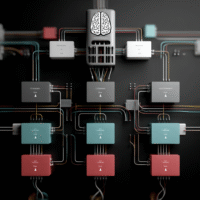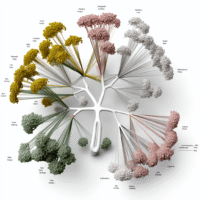AI Tech News
-
Top 9 Speaker Diarization Libraries and APIs for Technical Professionals in 2025
Understanding Speaker Diarization Speaker diarization is a crucial technology that helps us understand audio recordings by identifying “who spoke when.” This process is especially important in various fields such as call centers, legal proceedings, healthcare, and media. By segmenting an audio stream and labeling each segment by speaker identity, diarization enhances the clarity of transcripts […] ➡️➡️➡️
-
NVIDIA Streaming Sortformer: Real-Time Speaker Diarization for Enhanced Meeting Productivity
Understanding NVIDIA’s Streaming Sortformer NVIDIA’s Streaming Sortformer is a groundbreaking tool designed to enhance real-time speaker diarization. This technology is particularly valuable for professionals in various fields, including AI managers, content creators, digital marketers, and business professionals. These individuals often face challenges in accurately capturing and analyzing conversations with multiple speakers, especially in noisy environments. […] ➡️➡️➡️
-
Discover DeepSeek-V3.1: The Cost-Effective AI Language Model Transforming Research and Development
What is DeepSeek-V3.1 and Why is Everyone Talking About It? The Chinese AI startup DeepSeek has recently launched DeepSeek-V3.1, its latest flagship language model. This model builds on the architecture of its predecessor, DeepSeek-V3, and introduces significant enhancements in reasoning, tool use, and coding performance. DeepSeek models have gained a reputation for delivering performance comparable […] ➡️➡️➡️
-
Transform Research Papers into Production-Ready Code with DeepCode: A Game Changer for Researchers and Developers
Understanding the Target Audience DeepCode is designed for a diverse group of users, primarily researchers, software engineers, and academic professionals. These individuals often face significant challenges when translating complex research into functional software. Common pain points include: Time-consuming manual coding processes from research papers. Lack of reproducibility in research implementations. Difficulty in quickly prototyping software […] ➡️➡️➡️
-
South Korea’s Leading AI Models: Innovations in Language Technology
South Korea is emerging as a significant player in the field of large language models (LLMs), thanks to a combination of government support, corporate innovation, and academic research. This strategic focus not only aims to reduce reliance on foreign technologies but also enhances data privacy and fosters advancements in critical sectors such as healthcare, education, […] ➡️➡️➡️
-
Liquid AI Launches LFM2-VL: Fast Vision-Language Models for Developers and Enterprises
Introduction to LFM2-VL Liquid AI has made a significant leap in the field of artificial intelligence with the release of LFM2-VL, a new family of vision-language foundation models. These models are tailored for low-latency and device-aware deployment, making them suitable for various devices such as smartphones, laptops, and wearables. With two variants, LFM2-VL-450M and LFM2-VL-1.6B, […] ➡️➡️➡️
-
ZenFlow: Revolutionizing LLM Training with Stall-Free Offloading for AI Developers
Introduction to ZenFlow In the world of large language model (LLM) training, efficiency is key. The introduction of ZenFlow by the DeepSpeed team is set to revolutionize the way we handle GPU resources. Traditionally, training models has come with various bottlenecks, especially when it comes to CPU-induced stalls. For example, fine-tuning a model like Llama […] ➡️➡️➡️
-
PyTorch vs TensorFlow: The Ultimate Deep Learning Framework Comparison for 2025
Deep Learning Framework Showdown: PyTorch vs TensorFlow in 2025 The choice between PyTorch and TensorFlow remains one of the most debated decisions in AI development. Both frameworks have evolved dramatically since their inception, converging in some areas while maintaining distinct strengths. This article explores the latest patterns from a comprehensive survey paper from Alfaisal University, […] ➡️➡️➡️
-
Google AI Launches 5 New Agents to Transform Developer Workflows
Introduction to Google AI’s New Agents Google Cloud has recently introduced five innovative AI agents aimed at enhancing developer workflows. These tools are designed to reduce manual tasks, speed up data analysis, and simplify automation processes. Each agent targets specific challenges faced by developers, from managing data pipelines to improving GitHub repository handling. Let’s delve […] ➡️➡️➡️
-
Migrating to Model Context Protocol (MCP): A Step-by-Step Guide for Developers and Architects
Understanding the Target Audience The target audience for this playbook includes architects, developers, and business managers involved in AI integrations. These professionals often face challenges such as: Difficulty managing and maintaining custom integrations High technical debt due to brittle code Challenges in achieving interoperability between systems The need for scalable, flexible solutions that reduce integration […] ➡️➡️➡️
-
Unlock Excel’s Potential: Discover the Game-Changing =COPILOT() Function for Enhanced Data Analysis
Understanding the COPILOT Function in Excel Excel has taken a major leap forward with the introduction of the COPILOT function. This feature allows users to interact with their data using natural language, making complex tasks simpler and more intuitive. By leveraging artificial intelligence, COPILOT can analyze, summarize, and even generate new data based on user […] ➡️➡️➡️
-
Unlocking Reliable LLM Evaluation: Boost AI Decision-Making with Signal-to-Noise Insights
Understanding Signal and Noise in LLM Evaluation What is Signal? Signal measures how well a benchmark can differentiate between better and worse models. High signal implies distinct performances across different models, allowing for clear rankings. Conversely, a low signal results in closely clustered scores, making it hard to determine which model excels. What is Noise? […] ➡️➡️➡️
-
Build a Self-Hosted LLM Workflow with Ollama, REST API, and Gradio
Understanding the Target Audience The tutorial on building a self-hosted LLM workflow with Ollama, REST API, and Gradio Chat Interface is tailored for a diverse audience. Key groups include: Data Scientists and AI Practitioners: These individuals are eager to implement machine learning models in real-world applications. Software Developers: Developers looking to integrate AI capabilities into […] ➡️➡️➡️
-
Unlocking the Future: M3-Agent’s Multimodal Intelligence with Long-Term Memory
Understanding M3-Agent Imagine a future where a home robot can manage daily chores on its own, learning your habits and preferences over time. This is the promise of M3-Agent, a cutting-edge multimodal agent designed to enhance our daily lives through advanced artificial intelligence. By integrating long-term memory and reasoning capabilities, M3-Agent can remember user habits, […] ➡️➡️➡️
-
NVIDIA’s Nemotron Nano 2: Transforming Enterprise AI with 6x Faster Performance
Understanding the Target Audience for NVIDIA AI’s Nemotron Nano 2 Release The launch of NVIDIA’s Nemotron Nano 2 AI models targets a diverse group of professionals, including AI researchers, data scientists, business executives, and IT decision-makers. These individuals are eager to utilize cutting-edge AI technologies to enhance operational efficiency and foster innovation within their organizations. […] ➡️➡️➡️
-
Enhancing LLM Efficiency with Memp: A Task-Agnostic Framework for Procedural Memory Optimization
Understanding the Target Audience for Memp The Memp framework is tailored for a diverse audience, including AI researchers, business managers, and technology decision-makers. These individuals are keen on optimizing language model agents for practical applications. Typically, they possess a strong understanding of AI technologies and are in search of innovative solutions to enhance operational efficiency. […] ➡️➡️➡️
-
Emerging AI Trends in Cybersecurity: Top Tools Shaping 2025
Understanding Emerging Trends in AI Cybersecurity Defense The landscape of cybersecurity is evolving rapidly, driven by the increasing sophistication of cyber threats. Organizations are now turning to artificial intelligence (AI) to bolster their defense strategies. This article explores the key trends shaping AI-powered cybersecurity defense as we look toward 2025. AI-Powered Threat Detection and Automated […] ➡️➡️➡️
-
BlackRock AlphaAgents: Revolutionizing Equity Portfolio Management with Multi-Agent AI
The Rise of Multi-Agent Systems in Equity Research As the financial landscape evolves, the integration of artificial intelligence (AI) is becoming increasingly vital. Traditional equity portfolio management relies heavily on human analysts who sift through mountains of data, including financial statements, news reports, and market indicators. However, this human-centric approach is prone to cognitive biases, […] ➡️➡️➡️
-
Master Vibe Coding: Essential Insights for Data Engineers to Enhance Productivity
Understanding the Target Audience The primary audience for this article consists of data engineers eager to improve their coding efficiency and manage data pipelines effectively using AI tools. These professionals often face challenges such as slow prototyping, maintaining data integrity, and ensuring thorough documentation. Their objectives include streamlining workflows, minimizing technical debt, and enhancing data […] ➡️➡️➡️
-
Unleash Creativity with Qwen-Image-Edit: Advanced Image Editing for Professionals
Understanding Qwen-Image-Edit Launched in August 2025, Qwen-Image-Edit is a remarkable tool developed by Alibaba’s Qwen Team. It builds on the foundation of Qwen-Image, boasting a 20B-parameter model that enhances image editing capabilities. This tool is specifically designed for professionals in digital marketing, graphic design, content creation, and AI development. Users in these fields often seek […] ➡️➡️➡️



















